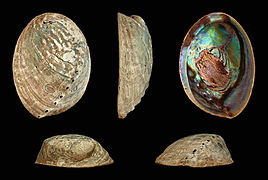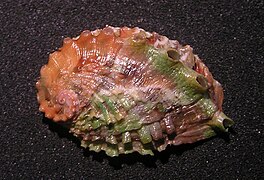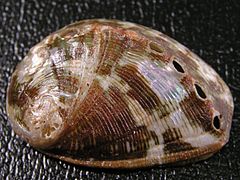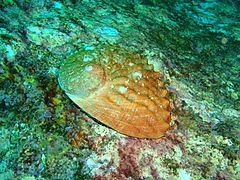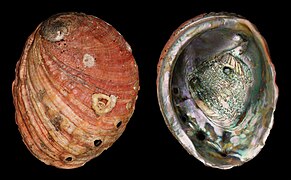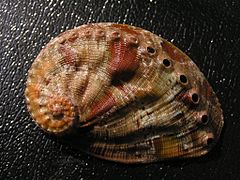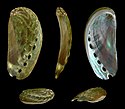Ušňovití
 Ušeň červená (Haliotis rufescens) | |
| Vědecká klasifikace | |
| Říše | živočichové (Animalia) |
| Kmen | měkkýši (Mollusca) |
| Třída | plži (Gastropoda) |
| Nadčeleď | Haliotoidea |
| Čeleď | ušňovití (Haliotidae) Rafinesque, 1815 |
| Rod | ušeň (Haliotis) Linnaeus, 1758 |
| Typový druh | |
| Haliotis asinina Linnaeus, 1758 | |
| Některá data mohou pocházet z datové položky. | |
Ušňovití (Haliotidae) je čeleď plžů. Jedná se o monotypickou čeleď, s jediným rodem ušeň (Haliotis).
Popis
Mají silnou nízkou oválnou ulitu se širokým prvním závitem (tvar ušního boltce). Její vnitřní strana je pokryta perletí. Na okraji je řada malých otvorů, které se během růstu postupně uzavírají. Posledních pět až devět jamek zůstává otevřených. Těmi může protékat mořská voda, která vnikla do plášťové dutiny. Plži se svalnatou nohou pevně přichycují na kameny a korály. Existuje přibližně sedmdesát druhů této čeledi. Největším zástupcem rodu je ušeň červená (Haliotis rufescens) dorůstající velkosti až 30 cm. Vyskytuje se téměř ve všech teplých mořích.
Význam
Ušně jsou jedlé. Konzumují se jejich svalnaté nohy. Zpracovává se perleť ulit, např. z novozélandské ušně duhové (Haliotis iris).
Galerie
Ušeň v akváriu
Haliotis asinina
Haliotis australis
Haliotis clathrata
Haliotis coccoradiata
Haliotis corrugata
Haliotis cracherodii
Haliotis cyclobates
Haliotis discus discus
Haliotis diversicolor
Haliotis elegans
Haliotis fatui
Haliotis fulgens fulgens
Haliotis gigantea f. sieboldii
Haliotis glabra
Haliotis iris
Haliotis jacnensis
Haliotis kamtschatkana assimilis
(jižní Kalifornie).Haliotis laevigata (jižní Austrálie).
Haliotis madaka
Haliotis mariae
Haliotis marmorata
Haliotis midae
Haliotis ovina
Haliotis parva
Haliotis planata
Haliotis pulcherrima
Haliotis queketti
Haliotis roei
Haliotis rubra
Haliotis rufescens
- © Hans Hillewaert, CC BY-SA 4.0
Haliotis rugosa
Haliotis scalaris
Haliotis semiplicata
Haliotis sorenseni
Haliotis spadicea
Haliotis squamosa
Haliotis stomatiaeformis
Haliotis supertexta
Haliotis thailandis
Haliotis tuberculata (Evropa)
Haliotis unilateralis
Haliotis varia
Haliotis virginea
Haliotis walallensis
Reference
V tomto článku byl použit překlad textu z článku Seeohren na německé Wikipedii.
Externí odkazy
 Obrázky, zvuky či videa k tématu ušeň na Wikimedia Commons
Obrázky, zvuky či videa k tématu ušeň na Wikimedia Commons  Taxon Haliotidae ve Wikidruzích
Taxon Haliotidae ve Wikidruzích- Čeleď haliotidae na webu rybicky.net/
Média použitá na této stránce
Autor:
- Information-silk.png: Mark James
- derivative work: KSiOM(Talk)
A tiny blue 'i' information icon converted from the Silk icon set at famfamfam.com
Autor: H. Zell, Licence: CC BY-SA 3.0
Haliotis discus discus Reeve, 1846, Ezo Abalone; Length 8.6 cm; Originating from Japan; Shell of own collection, therefore not geocoded.
Photo of the shell of Haliotis virginea. Locality: Philippines, Own Collection. Philippines. Cebu.
Autor: James St. John, Licence: CC BY 2.0
Haliotis scalaris (Leach, 1814) - exterior surface of a staircase abalone from Australia (BMSM 3267, Bailey-Matthews Shell Museum, Sanibel Island, Florida, USA).
The gastropods (snails & slugs) are a group of molluscs that occupy marine, freshwater, and terrestrial environments. Most gastropods have a calcareous external shell (the snails). Some lack a shell completely, or have reduced internal shells (the slugs & sea slugs & pteropods). Most members of the Gastropoda are marine. Most marine snails are herbivores (algae grazers) or predators/carnivores.
The abalones are an odd group of gastropods that have a coiled, cap-shaped, aragonite shell with a curvilinear set of excurrent respiratory holes. Interior shell surfaces have intensely iridescent nacreous aragonite ("mother of pearl"). Abalones are hard substrate algae grazers.
From museum signage [typos and mis-spellings corrected]: "Abalones are gastropod molluscs that typically have a widely open shell with holes. The holes serve to expel water after it circulates through the animal during breathing. Some abalones have very elegant shapes and striking colors and their beauty is boosted by the presence of a colorful layer of mother-of-pearl lining the interior of the shell."
"There are about 75 species of abalone. These species live on submerged rocks along different continents and islands, usually in cold water areas The West Coast of the U.S. is rich in abalone species. Abalones attach themselves to the rocks using a powerful shell muscle. They are herbivores, grazing on seaweed, with help from a set of specialized teeth called a radula."
Classification: Animalia, Mollusca, Gastropoda, Haliotidae
Locality: Quinn's Rocks, Western Australia
More info. at: en.wikipedia.org/wiki/Haliotis and
en.wikipedia.org/wiki/Haliotis_scalarisHaliotis unilateralis J. B. Lamarck, 1822, an abalone from the family Haliotidae; Israel
Haliotis sorenseni Bartsch, 1940; family Haliotidae; California
Autor: H. Zell, Licence: CC BY-SA 3.0
Midas Ear Abalone; Length 16 cm; Originating from South Africa; Shell of own collection, therefore not geocoded.
Dorsal, lateral (right side), ventral, back, and front view.
This picture consists of 5 single photos. The metadata refer to the dorsal view.
Dorsal view of a shell of Haliotis walallensis
Haliotis supertexta Lischke, 1870; family Haliotidae; Taiwan
Dorsal view of a shell of Haliotis coccoradiata. Own Collection. Australia, New South Wales, Sydney. Under rock.
Autor: H. Zell, Licence: CC BY-SA 3.0
Rainbow Abalone; Length 13.5 cm; Originating from New Zealand; Shell of own collection, therefore not geocoded.
Haliotis elegans Koch in Philippi, 1844; family Haliotidae; Western Australia
Haliotis semiplicata Menke, 1843; family Haliotidae; Western Australia
Haliotis squamosa Gray, 1826 (synonym: Haliotis crebrisculpta); family Haliotidae; Queensland, Australia
Autor: H. Zell, Licence: CC BY-SA 3.0
Green Abalone; Length 13 cm; Originating from Baja California, Mexico; Shell of own collection, therefore not geocoded
Haliotis rufescens Swainson, 1822. Red Abalone, USA. 22 cm.
Autor: H. Zell, Licence: CC BY-SA 3.0
Ass's Ear Abalone; Length 4.0 cm; Originating from the West-Pacific; Shell of own collection, therefore not geocoded.
Dorsal, lateral (right side), ventral, back, and front view.
Haliotis roei Gray, 1826; family Haliotidae; Western Australia
Haliotis stomatiaeformis L. A. Reeve, 1846, an abalone from the family Haliotidae
Haliotis jacnensis L. A. Reeve, 1846, an abolone in the family Haliotidae: Philippines
Autor: Sharktopus, Licence: CC BY-SA 3.0
Living abalone showing epipodium and tentacles, in display tank at Ty Warner Sea Center on Stearns Wharf, Santa Barbara, California.
Haliotis parva Linnaeus, 1758; family Haliotidae; South Africa
Autor: Peter Southwood, Licence: CC BY-SA 3.0
Blacklip abalone Haliotis rubra at Mistaken Cape, Maria Island, Tasmania
Haliotis fatui Geiger, 1999; family Haliotidae; Tonga Island
Dorsal view of a shell of H. cyclobates
Autor: H. Zell, Licence: CC BY-SA 3.0
Haliotis gigantea var. sieboldii Reeve, 1846 , Siebold's Giant Abalone; Length 9.7 cm; Originating from Japan. Shell of own collection, therefore not geocoded.
Haliotis pulcherrima Gmelin, 1791; family Haliotidae; Tuamotu
Haliotis madaka (Habe, 1977); family Haliotidae; Japan
Autor: H. Zell, Licence: CC BY-SA 3.0
Lovely Abalone; Length 3.2 cm; Originating from the Philippines; Shell of own collection, therefore not geocoded.
Dorsal, lateral (right side), ventral, back, and front view.
Dorsal view of a shell of H. corrugata
Autor: James St. John, Licence: CC BY 2.0
Haliotis spadicea Donovan, 1808 - exterior surface of a blood-spotted abalone from South Africa (public display, Bailey-Matthews Shell Museum, Sanibel Island, Florida, USA).
The gastropods (snails & slugs) are a group of molluscs that occupy marine, freshwater, and terrestrial environments. Most gastropods have a calcareous external shell (the snails). Some lack a shell completely, or have reduced internal shells (the slugs & sea slugs & pteropods). Most members of the Gastropoda are marine. Most marine snails are herbivores (algae grazers) or predators/carnivores.
The abalones are an odd group of gastropods that have a coiled, cap-shaped, aragonite shell with a curvilinear set of excurrent respiratory holes. Interior shell surfaces have intensely iridescent nacreous aragonite ("mother of pearl"). Abalones are hard substrate algae grazers.
From museum signage [typos and mis-spellings corrected]: "Abalones are gastropod molluscs that typically have a widely open shell with holes. The holes serve to expel water after it circulates through the animal during breathing. Some abalones have very elegant shapes and striking colors and their beauty is boosted by the presence of a colorful layer of mother-of-pearl lining the interior of the shell."
"There are about 75 species of abalone. These species live on submerged rocks along different continents and islands, usually in cold water areas The West Coast of the U.S. is rich in abalone species. Abalones attach themselves to the rocks using a powerful shell muscle. They are herbivores, grazing on seaweed, with help from a set of specialized teeth called a radula."
The blood-spotted abalone shown above is part of the South African Province: "The huge waves and cool waters of South Africa have produced a molluscan fauna dominated along its rocky shores by large limpets and abalones. Its beaches are often strewn with colorful, offshore cones, trochids and volutes. At certain seasons the cast-off egg-cradles of three species of paper nautiluses are found abundant on some beaches." [info. from museum signage}
Classification: Animalia, Mollusca, Gastropoda, Haliotidae
Locality: unrecorded locality in South Africa
More info. at: en.wikipedia.org/wiki/Haliotis and
en.wikipedia.org/wiki/Haliotis_spadiceaAutor: H. Zell, Licence: CC BY-SA 3.0
Haliotis kamtschatkana assimilis Dall, 1878, Threaded Abalone; Length 7.7 cm; Originating from the Baja California Peninsula, Mexico. Shell of own collection, therefore not geocoded.
Autor: H. Zell, Licence: CC BY-SA 3.0
Variable Abalone; Length 4.4 cm; Originating from Bohol, Philippines; Shell of own collection, therefore not geocoded.
Dorsal, lateral (right side), ventral, back, and front view.
Haliotis mariae W. Wood, 1828; family Haliotidae; Muscat Oman
Haliotis thailandis Dekker & Pakamanthin, 2001, an abalone from the family Haliotidae; Philippines
Autor: H. Zell, Licence: CC BY-SA 3.0
Planate Abalone; Length 3.1 cm; Originating from the Indo-Pacific; Shell of own collection, therefore not geocoded.
Dorsal, lateral (right side), ventral, back, and front view.
Haliotis marmorata Linnaeus, 1758; family Haliotidae; Senegal
Autor: H. Zell, Licence: CC BY-SA 3.0
Haliotis ovina ovina Gmelin, 1791, Sheep's Ear Abalone; Length 6.0 cm; Originating from the Philippines; Shell of own collection, therefore not geocoded.
Dorsal, lateral (right side), ventral, back, and front view.
Autor: H. Zell, Licence: CC BY-SA 3.0
Haliotis laevigata Donovan, 1808, Green Lip Abalone, green form; Length 7.5 cm; Originating from South Australia, Australia; Shell of own collection, therefore not geocoded.
Autor: H. Zell, Licence: CC BY-SA 3.0
Green Ormer; Length 7.4 cm; Originating from the Atlantic coast about 200 km south of Dakhla, Western Sahara; Shell of own collection, therefore not geocoded.
Dorsal view of a shell of H. cracherodii
Haliotis queketti E. A. Smith, 1910; family Haliotidae; South Africa
Haliotis australis Gmelin, 1791; family Haliotidae; New Zealand
Autor: H. Zell, Licence: CC BY-SA 3.0
Glistening Abalone; Length 4.1 cm; Originating from Japan; Shell of own collection, therefore not geocoded.
Dorsal, lateral (right side), ventral, back, and front view.
Autor: H. Zell, Licence: CC BY-SA 3.0
Variously Coloured Abalone; Length 8.5 cm; Originating from Japan; Shell of own collection, therefore not geocoded.
Dorsal, lateral (right side), ventral, back, and front view.















